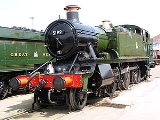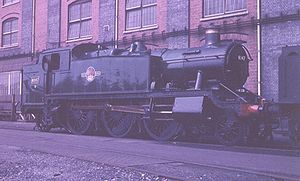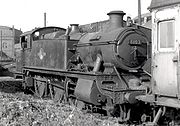
GWR 2-6-2T
Encyclopedia
The GWR 2-6-2T was the mainstay of the Great Western Railway
's suburban passenger services. Many classes were built and they were developed from one of George Jackson Churchward
's pioneer designs – the experimental No 99. The basic design was so sound that derivatives were built until the end of the company's life in 1948 and even beyond.
The development was gradual, but a little convoluted, and is summarised in this article.
.
) were produced using the larger standard number 4 boiler, again running at 200 psi. These two classes were the basis of what was to follow for over forty years.
but were really little changed from the first batch, having an increased axle loading of ; the maximum permitted for the ‘Blue’ route availability. Bunkers were of the standard Collett design with greater coal capacity.
Additions to the 5100 class were made until available numbers were exhausted, and 40 engines were then built in the 4100 series.
 1931 saw the next batch of engines, the initially 60-strong GWR 6100 Class
1931 saw the next batch of engines, the initially 60-strong GWR 6100 Class
. It had a useful alteration to the original design in the use of 225 psi (1.55 MPa) boiler pressure. This increased the tractive effort from 24300 to 27340 lbf (108.1 to 121.6 kN).
rebuilt some of the oldest locos in the 3100 series with a view to using them as bankers, particularly from Severn Tunnel Junction shed. One of the two classes of rebuilds was a "new" 3100 class derived from the old 3150 class. These engines used the standard class 4 boiler again, but pressed to 225 psi and with smaller coupled wheels of 5 in 3 in (1.6 m) in diameter, and a half inch increase in cylinder diameter, nominal tractive effort rose to 31170 lbf (138.7 kN). Almost impossible to notice was a 2 inch reduction in pony truck wheel diameter to 3 in 0 in (0.9144 m). Only five engines were ever modified, namely 3173, 3156, 3181, 3155 and 3179 which were rebuilt as 3100 to 3104 respectively.
 The other modified class was from the 5100 series (ex 3100). This was rebuilt into the 8100 class and retained the number 2 boiler, but again pressed to 225 psi as in the 6100. Coupled wheels were of (yet another trifling reduced size) 5 in 6 in (1.68 m) in diameter. These too had the 3-foot pony truck wheels. These were intended to bolster the 6100 class on London suburban duties with a supposed benefit of better acceleration. Just how much difference the 2 inch variance actually made is open to question, given that wheels were designed to wear down by about that amount in normal service. Whatever the practical performance advantage, the class became widely dispersed and locos were used alongside their predecessors indiscriminately.
The other modified class was from the 5100 series (ex 3100). This was rebuilt into the 8100 class and retained the number 2 boiler, but again pressed to 225 psi as in the 6100. Coupled wheels were of (yet another trifling reduced size) 5 in 6 in (1.68 m) in diameter. These too had the 3-foot pony truck wheels. These were intended to bolster the 6100 class on London suburban duties with a supposed benefit of better acceleration. Just how much difference the 2 inch variance actually made is open to question, given that wheels were designed to wear down by about that amount in normal service. Whatever the practical performance advantage, the class became widely dispersed and locos were used alongside their predecessors indiscriminately.
Just ten of these engines were rebuilt – numbers 5100 (the 1903 renumbered prototype number 99), 5123, 5118, 5145, 5124, 5126, 5120, 5116, 5133 and 5115, rebuilt as 8100 to 8109 respectively. In practical terms these were nothing more or less than the 6100 class with 2 inch smaller driving and pony truck wheels. In retrospect these rebuilds seem somewhat superfluous cases of fiddling with proven designs, given that later new builds reverted to the more or less original 1905 specification and dropped the non-standard driving wheel sizes and even the (probably more useful) higher boiler pressure.
The last 40 locomotives constructed were additions to the 4100 series in the final years of the GWR, and even into the second year of BR (WR) control.
wheel arrangement is nicknamed "Prairie", a name which originated in the USA. The name is completely inappropriate in Britain because there are no prairie
s but, nevertheless, it is often used. The locomotives described in this article are nicknamed "Large Prairies" while the smaller 4400
, 4500
and 4575
classes are nicknamed "Small Prairies".
Great Western Railway
The Great Western Railway was a British railway company that linked London with the south-west and west of England and most of Wales. It was founded in 1833, received its enabling Act of Parliament in 1835 and ran its first trains in 1838...
's suburban passenger services. Many classes were built and they were developed from one of George Jackson Churchward
George Jackson Churchward
George Jackson Churchward CBE was Chief Mechanical Engineer of the Great Western Railway in the United Kingdom from 1902 to 1922.-Early career:...
's pioneer designs – the experimental No 99. The basic design was so sound that derivatives were built until the end of the company's life in 1948 and even beyond.
The development was gradual, but a little convoluted, and is summarised in this article.
3100 class
No. 99 was produced in 1903 and given an extended trial over the ensuing two years. Fitted with the standard number 2 boiler running at 200 psi (1.38 MPa), flat topped tanks and driving wheels of 5 in 8 in (1.73 m) in diameter, this was the genesis of 289 similar locos that were to follow. 39 more examples were built to this initial design. This production batch differed from the prototype only in that the tank tops were sloping to aid visibility and the cab sides were incorporated into the tanks. The running numbers of this batch were 3111 to 3149 and the prototype was logically renumbered 3100 and the class became the GWR 3100 ClassGWR 3100 Class
The Great Western Railway 3100 Class was a class of 2-6-2T side tank steam locomotive. This was developed from one of George Jackson Churchward's pioneer designs; the experimental No 99...
.
3150 class
1906 saw the first alteration to the design of the class, when numbers 3150 to 3190 (known as the GWR 3150 ClassGWR 3150 Class
The Great Western Railway 3150 Class is a class of 2-6-2T side tank steam locomotive. Subclass of the large prairies and were heavy suburban passenger traffic engines.-External links:* *...
) were produced using the larger standard number 4 boiler, again running at 200 psi. These two classes were the basis of what was to follow for over forty years.
5100 and 5101 classes
A renumbering in 1927 saw the original 40 renumbered 5100 and 5111 to 5149; the following additions to the class filled in the numbers 5101 to 5110 and extended the class to 5189. These locos were known as the GWR 5101 ClassGWR 5101 Class
The GWR 5101 Class or Large Prairie was a class of 2-6-2T steam locomotives of the Great Western Railway. They were medium-sized tank engines used for suburban and local passenger services all over the Great Western Railway system...
but were really little changed from the first batch, having an increased axle loading of ; the maximum permitted for the ‘Blue’ route availability. Bunkers were of the standard Collett design with greater coal capacity.
Additions to the 5100 class were made until available numbers were exhausted, and 40 engines were then built in the 4100 series.
6100 class

GWR 6100 Class
The GWR 6100 Class is a class of prairie tank locomotives, designed by Charles Collett, and of the 2-6-2T arrangement.They were introduced in 1931 and were a straightforward development of the earlier 5101 class with little more than an increased boiler pressure of to distinguish them from their...
. It had a useful alteration to the original design in the use of 225 psi (1.55 MPa) boiler pressure. This increased the tractive effort from 24300 to 27340 lbf (108.1 to 121.6 kN).
New 3100 class
In 1938 CollettCharles Collett
Charles Benjamin Collett was chief mechanical engineer of the Great Western Railway from 1922 to 1941. He designed the GWR's 4-6-0 Castle and King Class express passenger locomotives.-Career:...
rebuilt some of the oldest locos in the 3100 series with a view to using them as bankers, particularly from Severn Tunnel Junction shed. One of the two classes of rebuilds was a "new" 3100 class derived from the old 3150 class. These engines used the standard class 4 boiler again, but pressed to 225 psi and with smaller coupled wheels of 5 in 3 in (1.6 m) in diameter, and a half inch increase in cylinder diameter, nominal tractive effort rose to 31170 lbf (138.7 kN). Almost impossible to notice was a 2 inch reduction in pony truck wheel diameter to 3 in 0 in (0.9144 m). Only five engines were ever modified, namely 3173, 3156, 3181, 3155 and 3179 which were rebuilt as 3100 to 3104 respectively.
8100 class

Just ten of these engines were rebuilt – numbers 5100 (the 1903 renumbered prototype number 99), 5123, 5118, 5145, 5124, 5126, 5120, 5116, 5133 and 5115, rebuilt as 8100 to 8109 respectively. In practical terms these were nothing more or less than the 6100 class with 2 inch smaller driving and pony truck wheels. In retrospect these rebuilds seem somewhat superfluous cases of fiddling with proven designs, given that later new builds reverted to the more or less original 1905 specification and dropped the non-standard driving wheel sizes and even the (probably more useful) higher boiler pressure.
The last 40 locomotives constructed were additions to the 4100 series in the final years of the GWR, and even into the second year of BR (WR) control.
Preservation
Ten engines of the 4100/5100 series have been preserved. They are 5164, 5193, 5199, 4110, 4115, 4121, 4141, 4144, 4150 and 4160. The last three had very short careers in BR ownership, their time in preservation now easily representing the majority of their lives.Prairie
The 2-6-22-6-2
Under the Whyte notation for the classification of steam locomotives, 2-6-2 represents the wheel arrangement of two leading wheels, six coupled driving wheels and two trailing wheels.Other equivalent classifications are:...
wheel arrangement is nicknamed "Prairie", a name which originated in the USA. The name is completely inappropriate in Britain because there are no prairie
Prairie
Prairies are considered part of the temperate grasslands, savannas, and shrublands biome by ecologists, based on similar temperate climates, moderate rainfall, and grasses, herbs, and shrubs, rather than trees, as the dominant vegetation type...
s but, nevertheless, it is often used. The locomotives described in this article are nicknamed "Large Prairies" while the smaller 4400
GWR 4400 Class
The Great Western Railway 4400 Class was a class of 2-6-2T side tank steam locomotive. They were introduced in 1904 for work on small branch lines.- External links :*...
, 4500
GWR 4500 Class
The Great Western Railway 4500 Class or Small Prairie is a class of steam locomotive. They are 2-6-2T type. A total of 75 were built; 55 were built in four batches between 1906 and 1915. A fifth batch of 20 locos was built in 1924, during Collett's tenure at Swindon. The first two batches were...
and 4575
GWR 4575 Class
The Great Western Railway 4575 Class is a class of steam locomotive. They are 2-6-2T Small Prairie type based on the 4500 Class but with larger side tanks...
classes are nicknamed "Small Prairies".

